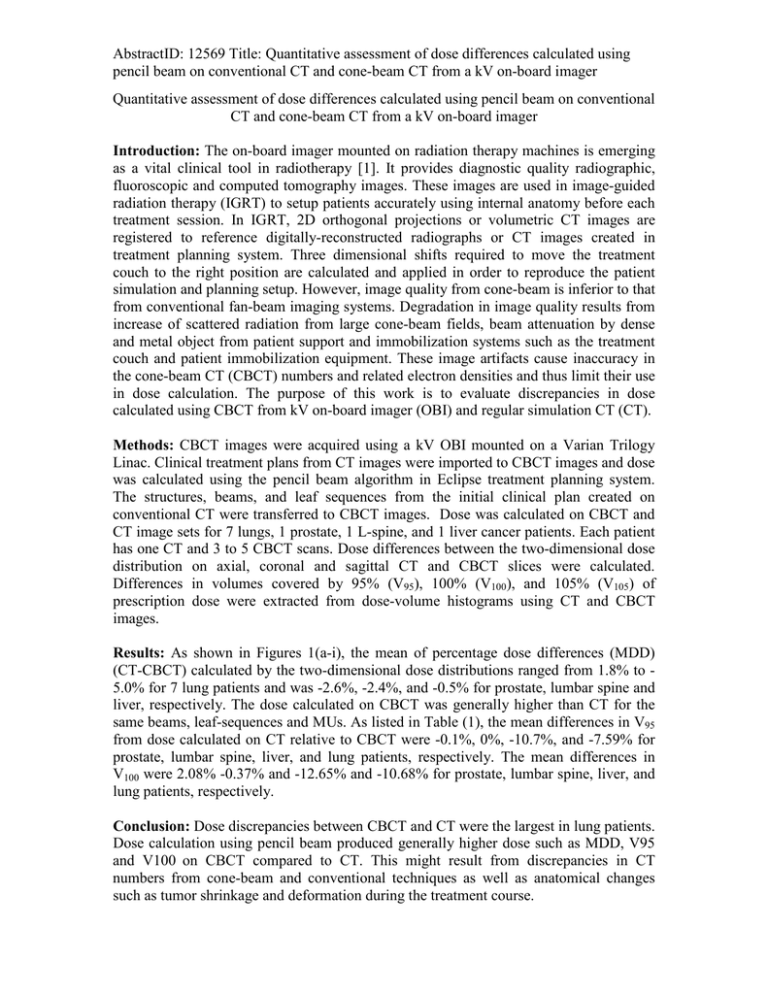AbstractID: 12569 Title: Quantitative assessment of dose differences calculated using
advertisement

AbstractID: 12569 Title: Quantitative assessment of dose differences calculated using pencil beam on conventional CT and cone-beam CT from a kV on-board imager Quantitative assessment of dose differences calculated using pencil beam on conventional CT and cone-beam CT from a kV on-board imager Introduction: The on-board imager mounted on radiation therapy machines is emerging as a vital clinical tool in radiotherapy [1]. It provides diagnostic quality radiographic, fluoroscopic and computed tomography images. These images are used in image-guided radiation therapy (IGRT) to setup patients accurately using internal anatomy before each treatment session. In IGRT, 2D orthogonal projections or volumetric CT images are registered to reference digitally-reconstructed radiographs or CT images created in treatment planning system. Three dimensional shifts required to move the treatment couch to the right position are calculated and applied in order to reproduce the patient simulation and planning setup. However, image quality from cone-beam is inferior to that from conventional fan-beam imaging systems. Degradation in image quality results from increase of scattered radiation from large cone-beam fields, beam attenuation by dense and metal object from patient support and immobilization systems such as the treatment couch and patient immobilization equipment. These image artifacts cause inaccuracy in the cone-beam CT (CBCT) numbers and related electron densities and thus limit their use in dose calculation. The purpose of this work is to evaluate discrepancies in dose calculated using CBCT from kV on-board imager (OBI) and regular simulation CT (CT). Methods: CBCT images were acquired using a kV OBI mounted on a Varian Trilogy Linac. Clinical treatment plans from CT images were imported to CBCT images and dose was calculated using the pencil beam algorithm in Eclipse treatment planning system. The structures, beams, and leaf sequences from the initial clinical plan created on conventional CT were transferred to CBCT images. Dose was calculated on CBCT and CT image sets for 7 lungs, 1 prostate, 1 L-spine, and 1 liver cancer patients. Each patient has one CT and 3 to 5 CBCT scans. Dose differences between the two-dimensional dose distribution on axial, coronal and sagittal CT and CBCT slices were calculated. Differences in volumes covered by 95% (V95), 100% (V100), and 105% (V105) of prescription dose were extracted from dose-volume histograms using CT and CBCT images. Results: As shown in Figures 1(a-i), the mean of percentage dose differences (MDD) (CT-CBCT) calculated by the two-dimensional dose distributions ranged from 1.8% to 5.0% for 7 lung patients and was -2.6%, -2.4%, and -0.5% for prostate, lumbar spine and liver, respectively. The dose calculated on CBCT was generally higher than CT for the same beams, leaf-sequences and MUs. As listed in Table (1), the mean differences in V95 from dose calculated on CT relative to CBCT were -0.1%, 0%, -10.7%, and -7.59% for prostate, lumbar spine, liver, and lung patients, respectively. The mean differences in V100 were 2.08% -0.37% and -12.65% and -10.68% for prostate, lumbar spine, liver, and lung patients, respectively. Conclusion: Dose discrepancies between CBCT and CT were the largest in lung patients. Dose calculation using pencil beam produced generally higher dose such as MDD, V95 and V100 on CBCT compared to CT. This might result from discrepancies in CT numbers from cone-beam and conventional techniques as well as anatomical changes such as tumor shrinkage and deformation during the treatment course. AbstractID: 12569 Title: Quantitative assessment of dose differences calculated using pencil beam on conventional CT and cone-beam CT from a kV on-board imager Coronal Sagital Axial a b c d e f g h i Figure 1: Dose distributions and differences from a single CBCT for lung patient 1. The data from the dose distributions in coronal plane with (a) isodose overlay, (b) percentage dose difference, and (c) dose difference histogram. The bold contours in the overlay images (a, d, g) represent dose from conventional CT-based dosimetry and fine lines representing CBCT-based dosimetry. The dose difference maps (b, e, h) show percent differences in dose by performing a pixel by pixel subtraction, and dose difference histograms are displayed graphically in (c, f, i) in coronal, saggittal, and axial planes, respectively. Average % V100 V105 V95 Lung Patients Patient 1 -2.45 Patient 2 -1.06 Patient 3 -2.76 Patient 4 -7.89 Patient 5a -11.57 Patient 5b -14.14 Patient 6a -8.44 Patient 6b -4.98 Patient 7 -15.02 Average -7.59 -0.60 6.41 -0.15 -19.48 -13.54 -23.62 -12.40 -6.22 -26.56 -10.68 28.56 58.79 45.74 -48.61 -5.31 -45.12 -7.07 0.19 -49.43 -2.48 Average % V100 V105 V95 Prostate Patient Patient 1 -0.10 2.08 69.42 L-Spine Patient Patient 1 0.00 -0.37 54.71 Liver Patient Patient 1 -10.74 -12.65 -16.13 Table 1: The average percent difference in dose covering PTV at V95, V100, and V105 [1] D. A. Jaffray and J.H. Siewerdsen, Cone-beam computed tomography with a flat

